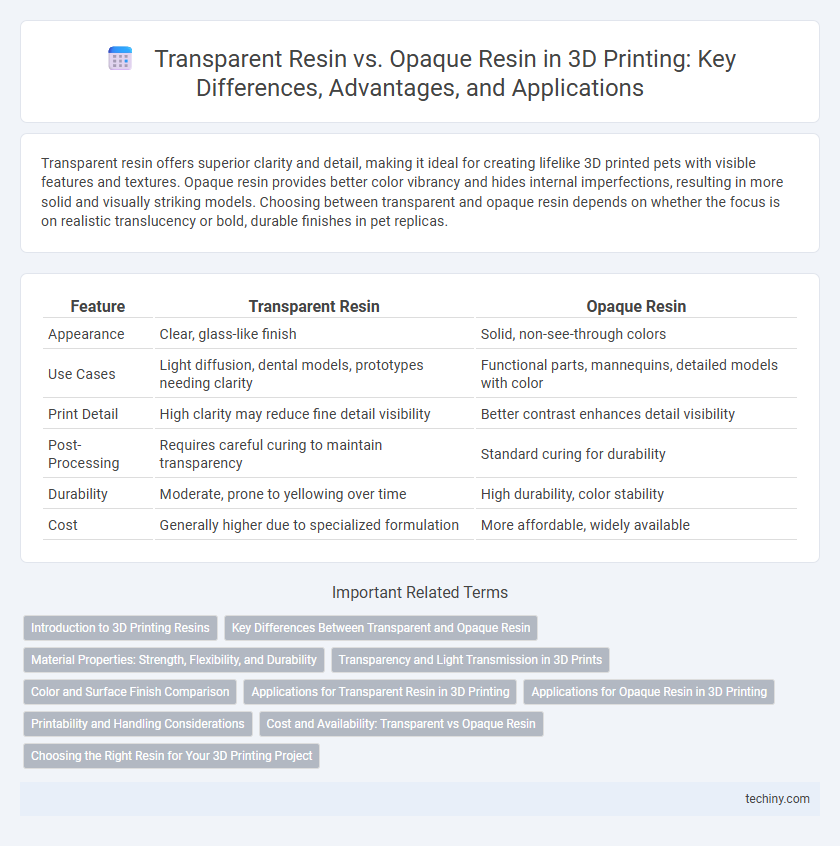Transparent resin offers superior clarity and detail, making it ideal for creating lifelike 3D printed pets with visible features and textures. Opaque resin provides better color vibrancy and hides internal imperfections, resulting in more solid and visually striking models. Choosing between transparent and opaque resin depends on whether the focus is on realistic translucency or bold, durable finishes in pet replicas.
Table of Comparison
| Feature | Transparent Resin | Opaque Resin |
|---|---|---|
| Appearance | Clear, glass-like finish | Solid, non-see-through colors |
| Use Cases | Light diffusion, dental models, prototypes needing clarity | Functional parts, mannequins, detailed models with color |
| Print Detail | High clarity may reduce fine detail visibility | Better contrast enhances detail visibility |
| Post-Processing | Requires careful curing to maintain transparency | Standard curing for durability |
| Durability | Moderate, prone to yellowing over time | High durability, color stability |
| Cost | Generally higher due to specialized formulation | More affordable, widely available |
Introduction to 3D Printing Resins
Transparent resin in 3D printing offers high clarity and light transmission, ideal for applications requiring visual inspection and aesthetic appeal, such as prototypes and eyewear. Opaque resin provides solid color coverage and better light-blocking properties, making it suitable for detailed models, mechanical parts, and medical devices that require opacity and strength. Both resin types play crucial roles in additive manufacturing, with material choice impacting final product properties like surface finish, durability, and post-processing ease.
Key Differences Between Transparent and Opaque Resin
Transparent resin in 3D printing offers superior light transmission, making it ideal for applications requiring clarity and fine detail, such as dental models and optical prototypes. Opaque resin, by contrast, provides better UV resistance and surface durability, making it suitable for functional parts and tools where color consistency and mechanical strength are prioritized. Key differences include transparency level impacting light cure depth, surface finish visibility, and specific use cases driven by optical versus structural requirements.
Material Properties: Strength, Flexibility, and Durability
Transparent resin in 3D printing offers moderate strength and flexibility, making it suitable for detailed, visually clear prototypes but less ideal for high-stress applications. Opaque resin typically provides enhanced durability and higher mechanical strength, supporting functional parts that require resistance to wear and impact. Both materials vary in flexibility based on formulation, but opaque resin generally delivers superior long-term performance under mechanical load.
Transparency and Light Transmission in 3D Prints
Transparent resin offers superior light transmission and clarity in 3D prints, making it ideal for applications requiring clear, glass-like finishes. In contrast, opaque resin blocks light, resulting in solid, non-transparent parts that are better suited for structural or aesthetic elements where transparency is not desired. Choosing between transparent and opaque resins depends significantly on the functional and visual requirements of the final 3D printed object.
Color and Surface Finish Comparison
Transparent resin offers superior clarity and light transmission, making it ideal for applications requiring visual depth and intricate internal details, whereas opaque resin provides consistent, solid coloration suited for vibrant, uniform models. The surface finish of transparent resin tends to be smoother and glossier, enhancing the visibility of fine textures, while opaque resin delivers a matte or semi-gloss finish that minimizes reflections and highlights color intensity. Selecting between transparent and opaque resin depends on the desired aesthetic and functional requirements of the printed object, with transparency enhancing visual complexity and opacity emphasizing bold, saturated colors.
Applications for Transparent Resin in 3D Printing
Transparent resin in 3D printing is ideal for applications requiring clear, glass-like finishes such as medical models, dental aligners, and optical components. Its clarity allows for detailed internal structures to be visualized, making it essential for prototyping intricate designs and fluid dynamics testing. This resin type supports industries focusing on aesthetics and functionality where light transmission and transparency are critical.
Applications for Opaque Resin in 3D Printing
Opaque resin in 3D printing is ideal for creating highly detailed, durable models used in prototyping, functional parts, and product design due to its ability to mask internal structures and provide vibrant color finishes. Its non-light-transmissive properties ensure consistent curing and enhance mechanical strength, making it suitable for engineering components and end-use products requiring structural integrity. Opaque resin also excels in aesthetic applications such as figurines and jewelry, where color fidelity and surface finish are critical.
Printability and Handling Considerations
Transparent resin offers superior printability for detailed models due to its light transmission properties, enabling precise layer curing and smooth surface finishes. Opaque resin provides easier handling and post-processing, as it resists yellowing and is less prone to show imperfections or dust during printing. Choosing between transparent and opaque resin depends on the balance between desired visual clarity and practical durability in 3D printing workflows.
Cost and Availability: Transparent vs Opaque Resin
Transparent resin typically costs more than opaque resin due to its specialized formulation and limited production volume, making it less widely available in the market. Opaque resin offers a broader range of color options and is generally more affordable, benefiting from higher demand and mass production. The cost difference and availability influence project budgeting and material selection in 3D printing workflows.
Choosing the Right Resin for Your 3D Printing Project
Transparent resin offers superior clarity and is ideal for projects requiring light transmission or visual depth, such as lenses or display models. Opaque resin provides greater color vibrancy and hides internal structures, making it suitable for detailed figurines or mechanical parts. Selecting the right resin depends on your project's visual requirements and functional needs, balancing aesthetics with material properties like strength and curing time.
Transparent resin vs Opaque resin Infographic

 techiny.com
techiny.com